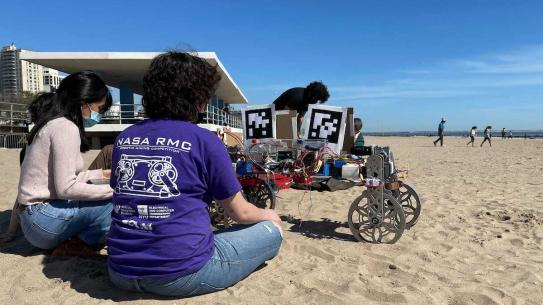What do Coney Island and Mars have in common? Ask the NYU Robotics Design Team

The NYU Robotics Design Team tested their Mars Rover in the sands of Coney Island. They took top honors in several categories in NASA’s annual Robotic Mining Competition.
It takes a lot to capture the attention of jaded New Yorkers, but carrying an autonomous, regolith-mining Mars rover on the subway from Downtown Brooklyn to Coney Island will generally do the trick, according to the members of the NYU Robotics Design Team.
The team used the iconic beach while preparing to take part in NASA’s annual Robotic Mining Competition, which challenges students from across the country to design and build a fully autonomous robot capable of mining regolith, the powdery substance that covers the surface of Mars. While fun, the contest has a serious purpose: In order to sustain human life on Mars and enable a return trip back to Earth, NASA is researching In-Situ Resource Utilization (ISRU). If robotic excavators can be developed to extract raw resources like regolith, they can then be converted into water, fuel, building media, and other useful materials.
The sand at Coney Island, augmented with a base layer of gravel, stood in for Martian regolith as the team tested PIPER (Project Inter-Planetary Excavation Rover), drawing awed crowds as the autonomous machine excavated the material and deposited it at a collection point — with the goal being to gather as much as possible, as quickly and efficiently as possible.
“PIPER is actually named after one of the children who became particularly excited while watching us,” Angy Noemy Lara, the team captain explained. “It was a lucky coincidence that it turned out to be a great acronym. Now that she’s had a Mars rover named after her, maybe the human Piper will be inspired to explore engineering.”
The long subway rides and testing paid off: the team won the top prize in the innovation category, thanks in large part to an unusual set of legs that could raise and lower the excavator as needed; placed first in the live video presentation category, which had been instituted during COVID because competitors could not travel to the Kennedy Space Station to demonstrate their work; and were named one of the top teams overall. They also placed third in the public outreach category, because of the work they had done throughout the year with the city’s K-12 teachers and students — particularly challenging at a time of remote learning.
“I’m not surprised that they did so well,” Professor Giuseppe Loianno, who leads the Agile Robotics and Perception Lab at Tandon and serves as team advisor, said. “They’re very self-directed and motivated, and, most importantly, they’re a diverse group, with students from electrical and mechanical engineering, as well as computer science and several other majors. They really serve as an example of the power of collaboration and multidisciplinary cooperation.”
The Robotics Design Team is part of Tandon’s Vertically Integrated Projects program and is always looking for new members.
There are opportunities to join a wide variety of working groups, including:
- Community outreach
- Project Management
- Systems Engineering
- Mechanical Engineering
- Electrical / Computer Engineering
- Software Engineering (Computer Science)





